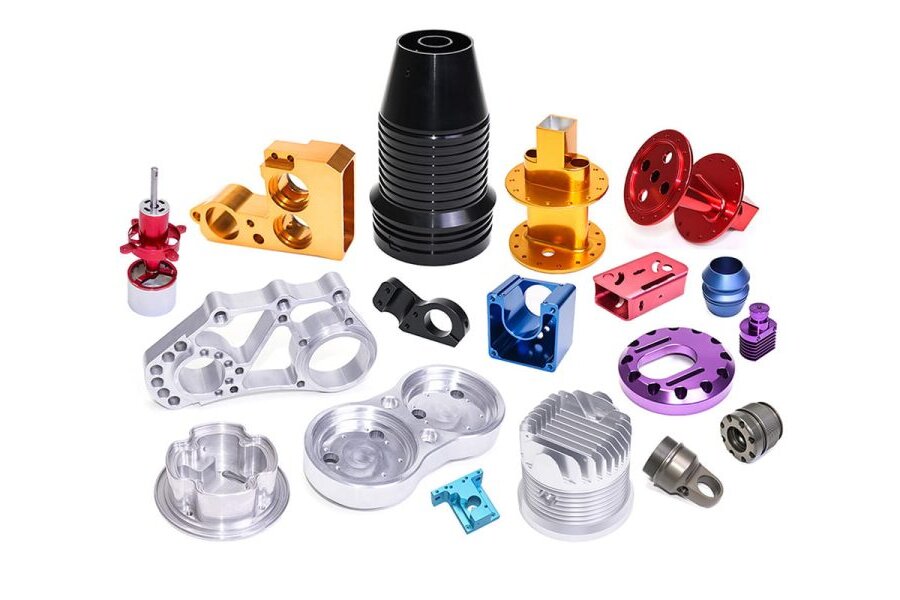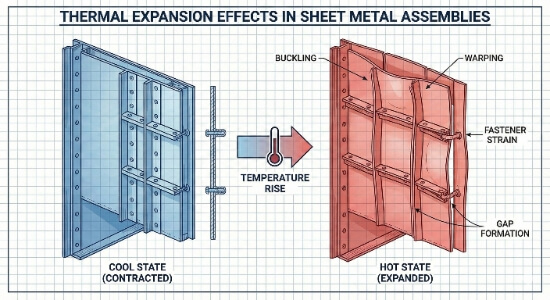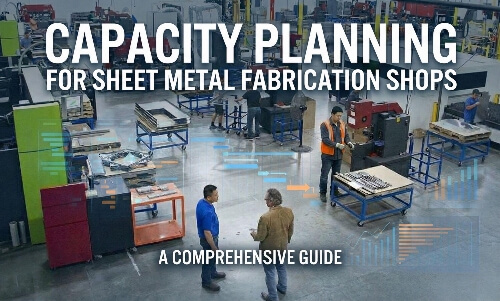Aluminum is commonly used in many industries because it is light and flexible. But what happens when aluminum undergoes anodizing? This process improves its qualities, making it stronger and more visually appealing. Whether you are in manufacturing, construction, or design, anodized aluminum could improve the performance and look of your products.
Anodizing enhances aluminum’s features and makes it suitable for a wide range of applications. Want to learn more about the different types of anodizing, their advantages, and where they’re used? Keep reading.

What is Anodized Aluminum?
Anodizing aluminum is an electrochemical process that increases the natural oxide layer on the surface of aluminum. The aluminum is immersed in an acid electrolyte solution during anodizing, and an electric current is passed through it. This causes the aluminum to react with the solution, forming an oxide layer much thicker than the natural oxide.
Unlike paint or plating, the coating is part of the metal, so it won’t peel or chip. The process also allows for dyeing the aluminum, which means anodized aluminum can come in various colors.
How to Anodize Aluminum?
Anodizing aluminum involves several carefully controlled steps to ensure the metal achieves its desired properties. Here’s a breakdown of each step in the process:
Step 1: Pre-Treatment
The pre-treatment phase is crucial to ensure the aluminum surface is clean and contaminant-free. This step typically involves:
- Cleaning: The aluminum is thoroughly cleaned using a chemical solution or abrasive method to remove dirt, grease, oils, or any residues.
- Etching: Sometimes, aluminum may be etched to remove imperfections and prepare it for anodizing. This can help ensure the oxide layer adheres properly.
- Rinsing: After cleaning and etching, the aluminum is rinsed to remove any remaining chemicals or residues.
Step 2: Anodizing
In the anodizing step, the aluminum is submerged in an electrolyte solution (usually sulfuric acid), and an electric current is passed through it. This creates an oxide layer on the surface. The key points in this phase include:
- Electrolyte Bath: The aluminum acts as the anode (positive electrode), while the cathode (negative electrode) is typically a metal like lead or stainless steel.
- Oxide Growth: The electric current causes oxygen ions to combine with the aluminum surface, creating a thick oxide layer.
- Control of Thickness: The thickness of the oxide layer is controlled by the amount of time the aluminum stays in the bath and the current’s strength. Thicker layers provide better corrosion resistance and wear resistance.
Step 3: Coloring
Once anodizing is complete, the aluminum can be colored. This is an optional but standard step, as anodized aluminum can be dyed to produce various colors. The coloring process involves:
- Dyeing: The anodized aluminum is submerged in a dye solution. The porous structure of the oxide layer absorbs the dye, resulting in vibrant colors.
- Types of Dyes: Both organic and inorganic dyes can be used, with organic dyes providing a wide range of colors, while inorganic dyes offer more durability and UV resistance.
- Coloring Time: When the aluminum is exposed to the dye, it influences the final color’s depth and richness.
Step 4: Sealing
Sealing is the final step in the anodizing process. Sealing aims to close the pores of the oxide layer and enhance its durability. There are different sealing methods, including:
- Hot Water Sealing: The anodized aluminum is immersed in hot water, which causes the pores to close. This increases corrosion resistance.
- Cold Sealing: A chemical sealant is applied to the surface to seal the pores.
- Steam Sealing: The aluminum is exposed to steam, which reacts with the oxide layer to form a sealed structure.

Types of Anodized Aluminum
Anodizing aluminum can be done in various ways, each designed to suit specific performance requirements. Let’s explore the most common types:
Type I: Sulfuric Acid Anodizing
Sulfuric acid anodizing is the most common type of anodizing. In this process, the aluminum is treated with sulfuric acid to form a thin oxide layer.
- Thickness: Typically, the oxide layer created by sulfuric acid anodizing ranges from 0.00002 to 0.0002 inch (0.5 to 5 microns).
- Properties: This layer provides good corrosion resistance moderate wear resistance, and is often used for decorative purposes. The anodized surface can also be dyed in a wide variety of colors.
- Applications: Commonly used for architectural applications, consumer electronics, and automotive parts where moderate durability and aesthetic appeal are required.
Type II: Hard Coat Anodizing
Hard coat anodizing (Type II) uses sulfuric acid anodizing but with a thicker oxide layer. This method improves aluminum’s wear and corrosion resistance.
- Thickness: The oxide layer thickness for Type II anodizing typically ranges from 0.0002 to 0.001 inches (5 to 25 microns), depending on the application.
- Properties: The thicker oxide layer enhances the aluminum’s hardness, wear resistance, and corrosion protection. It also allows for improved dyeing capabilities.
- Applications: Used in aerospace, automotive, and military applications where parts must withstand heavy use and environmental exposure.
Type III: Hard Anodizing for Extreme Durability
Type III anodizing, or “hard anodizing,” involves an even thicker oxide layer than Type II. This process is designed for extreme durability and performance in harsh environments.
- Thickness: The oxide layer for Type III anodizing typically ranges from 0.002 to 0.003 inches (50 to 75 microns), although it can be thicker in specific high-performance applications.
- Properties: The oxide layer is exceptionally thick, making it highly resistant to abrasion, corrosion, and wear. It also provides a unique matte finish that is highly durable.
- Applications: Ideal for parts used in military, aerospace, and industrial sectors where maximum performance is required, such as engine components, tooling, and structural parts.
Quick Comparison
Here’s a quick comparison of the three main types of anodized aluminum:
| Type | Thickness Range | Properties | Applications | Aesthetic/Coloring | Cost |
|---|---|---|---|---|---|
| Type I: Sulfuric Acid Anodizing | 0.5 to 5 microns | Good corrosion resistance, moderate wear resistance, easy to dye | Architectural, consumer electronics, automotive | High (easily dyed) | Low |
| Type II: Hard Coat Anodizing | 5 to 25 microns | Improved hardness, better wear and corrosion resistance, allows for dyeing | Aerospace, automotive, military, industrial equipment | High (can be dyed) | Moderate |
| Type III: Hard Anodizing | 50 to 75 microns | Extremely durable, highly abrasion-resistant, matte finish, maximum corrosion resistance | Military, aerospace, heavy industrial parts, tooling | Low (typically no dyeing) | High |
Which Type of Anodizing is the Best for You?
Choosing the correct type of anodizing depends on your specific application needs. Here’s a breakdown of which anodizing type might be best for you:
Type I: Sulfuric Acid Anodizing
- Best for: Decorative applications or when cost is a significant factor. It is ideal for parts exposed to moderate wear and environmental conditions.
- Key Advantages: It’s cost-effective, allows for vibrant dyeing, and is commonly used in architectural applications.
- Choose Type I if: You need a moderate level of corrosion and wear resistance, with a focus on aesthetics and lower cost.
Type II: Hard Coat Anodizing
- Best for: Applications where you need good wear and corrosion resistance without the extreme durability of Type III. This type is ideal for aerospace, automotive, and military parts that require durability but aren’t exposed to extreme conditions.
- Key Advantages: Offers improved hardness and better wear resistance compared to Type I, and still allows for dyeing.
- Choose Type II if: You need a balance between durability and cost, emphasizing function and appearance.
Type III: Hard Anodizing
- Best for: Extremely harsh environments where maximum durability and wear resistance are essential. This is often used in military, aerospace, and industrial sectors for parts that undergo heavy use.
- Key Advantages: Provides the highest corrosion and wear resistance due to the thick oxide layer. The finish is often matte and not typically dyed, ensuring durability over aesthetics.
- Choose Type III if: You need maximum protection against wear and corrosion and don’t require a decorative finish or vibrant coloring.
Benefits of Anodized Aluminum
Anodizing aluminum provides several benefits that enhance both its functionality and appearance. Here’s a look at some key advantages:
Durability
Anodized aluminum is highly durable. The anodizing process creates a hard surface that is resistant to scratching, abrasion, and fading, making it a popular choice for products that must withstand harsh conditions.
Corrosion Resistance
One of the most essential benefits of anodized aluminum is its increased resistance to corrosion. The anodized layer acts as a protective barrier against moisture and environmental factors, keeping the aluminum intact for longer.
Aesthetic Appeal
Anodizing allows aluminum to be dyed in a range of colors. The finish can be both visually appealing and functional.
Eco-Friendly
Anodizing is an environmentally friendly process. It uses minimal chemicals and creates little waste. The anodized layer is also non-toxic and can be disposed of safely.

Applications of Anodized Aluminum
Anodized aluminum is used in many industries due to its durability, corrosion resistance, and aesthetic appeal. Here are some typical applications:
Aerospace
Anodized aluminum is used in aerospace for aircraft frames, engine parts, and landing gear. The added corrosion resistance is crucial in high-stress environments.
Automotive
Anodized aluminum is widely used in automotive parts, including trim pieces, wheels, and heat exchangers. The anodized finish offers both protection and a sleek, professional appearance.
Architecture
Anodized aluminum is often used in building facades, window frames, and interior applications. Its ability to withstand weathering and attractive finish makes it a popular choice for modern architecture.
Electronics
The electronics industry uses anodized aluminum for smartphones, laptops, and home appliances. The anodized surface helps protect the device and adds a polished, premium look.
Consumer Goods
Anodized aluminum is used in a wide range of consumer goods, from kitchen utensils to sporting equipment. It provides an enhanced look and protects products from daily wear and tear.
Factors Influencing the Quality of Anodized Aluminum
The quality of anodized aluminum depends on several key factors. These elements greatly influence how well the anodizing process enhances the material’s properties. Here are the main factors that affect the final result:
Type of Aluminum Alloy
Different aluminum alloys react to anodizing in various ways. Some alloys, like 6061, anodize smoothly and evenly, giving a uniform finish. Others, like 7075, might result in a more uneven surface.
Thickness of Anodized Layer
The thickness of the anodized layer directly impacts durability, corrosion resistance, and overall performance. Thicker layers offer more protection and are more resistant to wear. However, thicker coatings can also make the surface look more matte, which might affect the finish’s appearance.
Process Variables
The anodizing process involves several factors that need careful control for good results. Temperature, voltage, and processing time all affect the thickness and look of the anodized layer. For example, higher voltage usually results in a thicker coating, while adjustments to temperature and time can impact color consistency and texture.
Sealing and Coating for Enhanced Performance
Sealing the anodized surface after the process can significantly improve its performance. Sealing locks in the anodized layer boost corrosion resistance and wear protection. Coatings, like dyed or clear finishes, are also applied for added visual appeal and durability.
Conclusion
Anodized aluminum is a versatile material with enhanced durability, corrosion resistance, and aesthetic appeal. By undergoing an electrochemical process, aluminum becomes more robust and visually attractive, making it ideal for the aerospace, automotive, and architecture industries.
Are you looking to incorporate anodized aluminum into your next project? Contact us today to learn how we can help you achieve high-quality, durable, and aesthetically pleasing results with anodized aluminum!
FAQs
What does anodizing aluminum do?
Anodizing aluminum improves its natural properties by adding a thicker oxide layer to the surface. This layer boosts the material’s resistance to corrosion and wear. It also makes aluminum more visually appealing and allows it to be dyed in various colors, making it suitable for many uses.
Is anodizing aluminum expensive?
Anodizing aluminum can be more expensive than basic finishes, as it involves a detailed process. The cost depends on factors like the aluminum type, the thickness of the anodized layer, and the job’s complexity.
What is the difference between hard anodizing and sulfuric anodizing?
Hard anodizing is a more intense process that creates a thicker, stronger oxide layer. This makes it ideal for high-durability uses. It offers better wear resistance than standard sulfuric anodizing, creating a thinner oxide layer typically used for decorative finishes.
How do you care for anodized aluminum surfaces?
To care for anodized aluminum, clean it regularly with mild detergent and warm water to remove dirt and debris. Avoid using abrasive cleaners or harsh chemicals, which can damage the anodized layer.
What colors can you anodize aluminum?
Anodizing aluminum allows for a wide range of colors. Standard colors include silver, gold, black, and bronze. Depending on the process, Aluminum can also be dyed in bright colors like red, blue, green, and purple.
Hey, I'm Kevin Lee

For the past 10 years, I’ve been immersed in various forms of sheet metal fabrication, sharing cool insights here from my experiences across diverse workshops.
Get in touch

Kevin Lee
I have over ten years of professional experience in sheet metal fabrication, specializing in laser cutting, bending, welding, and surface treatment techniques. As the Technical Director at Shengen, I am committed to solving complex manufacturing challenges and driving innovation and quality in each project.




